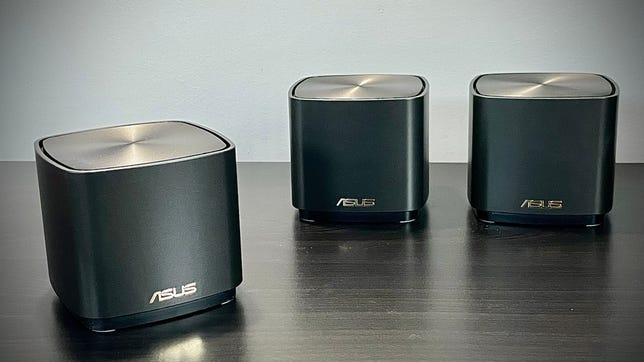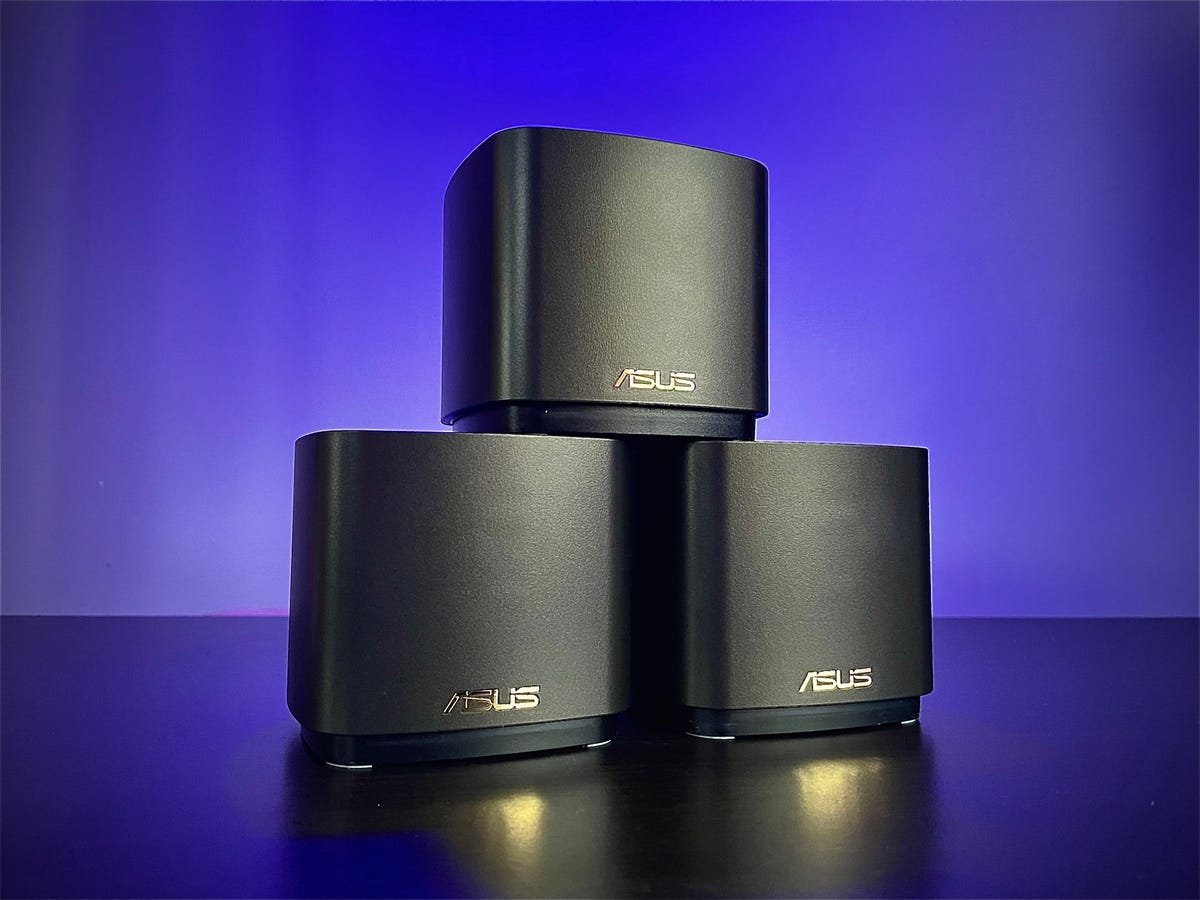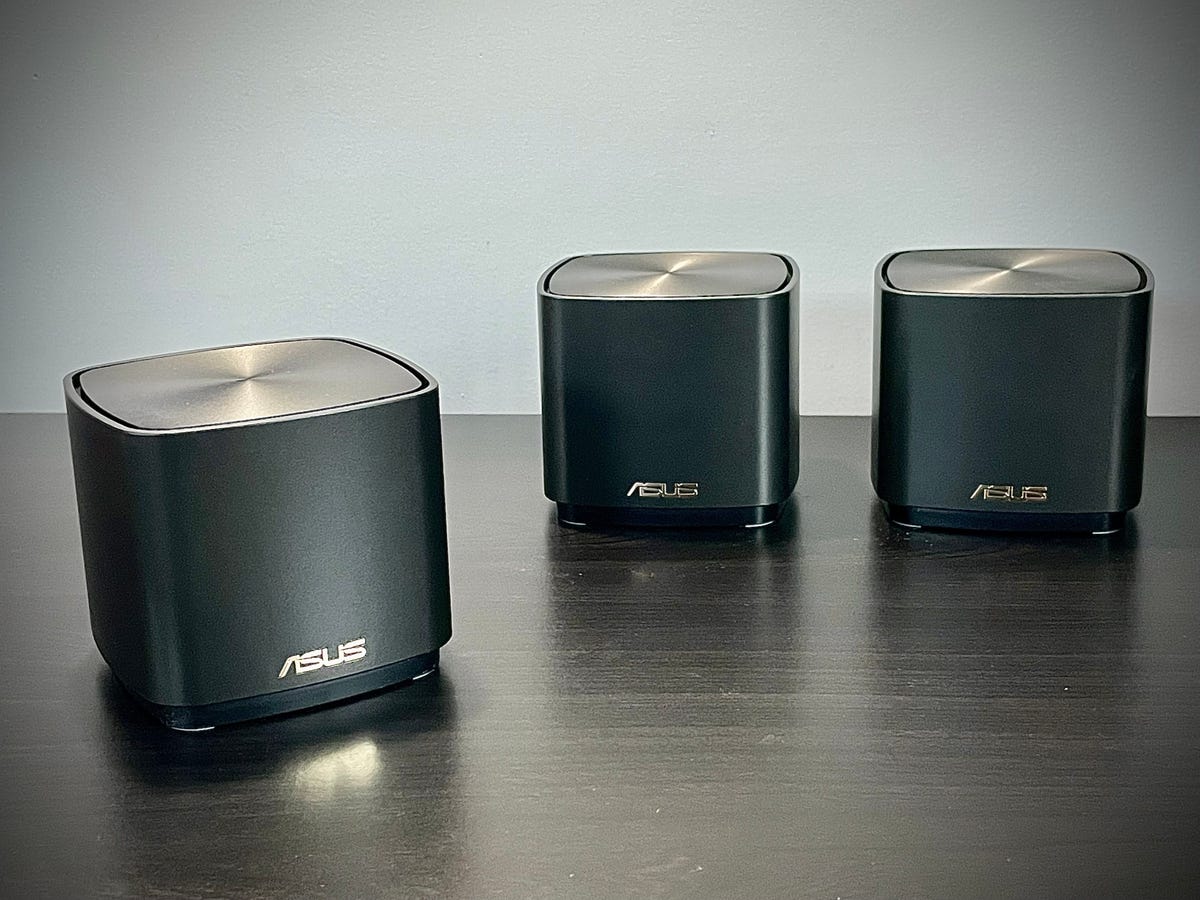
7.1
Asus ZenWiFi AX Mini
Like
Great-looking design available in black, white or woodgrain
Simple setup
Don’t like
Poor performance from the mesh compromises speed, especially when connecting from afar
Only one spare Ethernet jack on each device
If you’re just looking at the specs, the Asus ZenWiFi AX Mini seems like a no-brainer. It only costs $200 for a three-piece system, supports Wi-Fi 6 and looks pretty sharp for a Wi-Fi router. But that’s why we test these out — its real-world performance didn’t live up to the specs.
In my at-home tests, the ZenWiFi AX Mini was all over the map, with strange performance drop-offs that affected multiple devices and a mesh that routed my connection through the extender when it shouldn’t have, causing speeds to come crashing down even at close range. This is an attractive little mesh router, but you can find better performance at a similar price if you shop around.
With multiple devices relaying a stronger, more reliable signal from room to room, mesh routers promise a better Wi-Fi experience at home, and you’ve got a lot of new options with the newest and fastest generation of Wi-Fi.

A good first impression
There are lots of routers that take a minimalist approach to design, but that approach often leaves you with a bland, cheap-looking gadget. The ZenWiFi AX Mini steers clear of this trap with a quality build that looks great without commanding much attention. It’s not the router for you if you want a full array of LED indicator lights or a lot of spare ports to play with, but if you just want something simple and elegant that doesn’t take up much space, then you’ll likely be happy with what you get here.
Roughly the size of a Rubik’s Cube, each ZenWiFi AX Mini node is a dual-band AX1800 device, which means that it supports 802.11ax, or W-Fi 6, and that the top wireless speeds of the 2.4GHz and 5GHz bands add up to approximately 1,800 megabits per second (1.8 gigabits per second). You can only connect to one of those bands at a time, so the true top speed is 1,200Mbps, which is the top speed on the faster 5GHz band.
Packed inside each pint-size device is a pair of internal antennas, as well as 256MB of Flash memory and 256MB of RAM. That’s pretty much on par with other entry-level mesh routers, and less horsepower than you’ll find in fancier gaming routers or tri-band systems.
The Asus Router app will walk you through the setup process.
Ease of setup
Unlike some mesh routers, where every device in the system is fully interchangeable, the ZenWiFi AX Mini features a designated router with the Ethernet WAN port that connects to your modem and a spare Ethernet LAN port. The other two devices look identical, but they lack the WAN port. Asus helps avoid confusion by wrapping the main router device in a plastic band that says “Start to setup,” complete with a QR code that links to the router’s Wi-Fi network. Just plug the router into your modem and into power, wait a bit for it to boot up, and scan the code to connect to its network.
From there, you’ll want to use the Asus Router app on your Android or iOS device to finish setting things up. You’ll pick your network’s name and password, establish your admin credentials with Asus and wait a few minutes for the system to optimize. Then you’ll plug in the satellite nodes and wait for them to automatically join the mesh. It’s all very easy, but I’d caution that the Asus app isn’t quite as streamlined as similar apps from names like Eero, TP-Link or Nest, all of which do a slightly better job of idiot-proofing the setup process.
The ZenWiFi AX Mini (purple) wasn’t a performance standout, with average speeds that lagged behind much of the competition.
Scatterbrained performance
I spent a few days taking the ZenWiFi AX Mini for a test drive at my home in Louisville, Kentucky, a 1,300-square-foot shotgun-style house with a 300Mbps fiber connection where I’ve been testing home networking gear for the past few years (you can read all about how we test Wi-Fi routers here). The system held up fine for regular usage, but a close look at the speed test results reveals that the router was selling my connection short.
For starters, the system struggled with the same “sticky client” issues that I’ve seen plague a number of mesh routers, including other, similar dual-band Wi-Fi 6 models like the Eero 6 and the Netgear Nighthawk AX1800. In simpler terms, the mesh didn’t do a great job of routing my signal. If I moved from the front of my house where the router sits to the back of my house, it would recognize the change and begin routing my connection through the extender, which is fine. However, if I connected to the network in the back of the house and then moved to the front, the system would often fail to stop routing my connection through the extender even though it wasn’t necessary anymore. My laptop was “stuck” to the extender, or at least, its connection was.
Each dot in this chart is an individual speed test result for the ZenWiFi AX Mini. Ideally, you’d see lots of overlapping dots as high on the chart as possible, but persistent slowdowns and mesh issues made for a more chaotic result.
Connecting through the extender means that your Wi-Fi signal is making an additional jump on its way to the cloud, which slows things down. In my case, speeds close to the router in the living room fell from a near-perfect average of 297Mbps when I connected in the living room to an average of 252Mbps when I connected in the back of the house and then moved to the living room.
The ZenWiFi AX Mini’s average speeds also suffered from strange slowdowns that affected multiple devices at multiple points during my tests. For every router I test, I run full sets of speed tests throughout my home in the morning, afternoon and evening hours. The morning tests were normal, but by afternoon, something had changed, and I was seeing speeds no higher than 180Mbps or so in my living room, where I can usually connect at speeds slightly above my ISP limit of 300Mbps.
The slowdown persisted throughout the whole home, and on multiple devices, and didn’t seem to be a larger issue with the network, so I rebooted the router. That fixed things — but when the time came for my evening tests, the slowdown was back and I needed to reboot the router again. I ran some additional speed tests during subsequent days of tests and noticed additional slowdowns as well.
None of those slowdowns cut my connection outright — I was always able to browse, stream and surf on the network without interruption. Though I can’t be entirely sure at this point, it seems like the sort of slowdown that you’d see with a sticky client issue, albeit a more dramatic and annoying one than I’ve seen with other mesh routers.

The verdict
At $200, the Asus ZenWiFi AX Mini did an acceptable job of spreading a usable signal throughout my home, but issues with the mesh compromised my speeds, and that makes it tough to recommend. Even though it only comes with two devices instead of three, I’d still much rather have the TP-Link Deco W7200 running my network. That one adds in a tri-band design, which is key for optimizing mesh router performance, it boasts faster top speeds than the Asus and it essentially aced my performance tests, all while costing roughly the same price.
If you’re fixated on going with a ZenWiFi router, Asus has a tri-band version of its own called the ZenWiFi XT8 that also performed significantly better in our tests, as well as a more powerful dual-band model called the ZenWiFi XD6. Both of those would be a worthy step up from the mini-size XD4 system reviewed here.




















+ There are no comments
Add yours